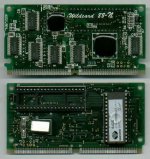Yes, in maximum mode it needs another chip to decode the R/W and other signals.
Here's the scheamtic:
http://kaput.homeunix.org/~thrashbarg/8088.png
It looks complicated, but the chip count is low (5 support chips for the 8080, 4 chips for address decoding, the rest are RAM/ROM and I/O devices).
I got the 8284 clock generator from the XT motherboard I stripped most of the components off. You may need to desolder it, mine was in a socket. If you want to run in maximum mode (it doesn't change the code or speed, just the number of signals available), you'll need to get the 8288 from a motherboard too. The XT runs in maximum mode.
Anything else should be answered in the 8088 datasheet which you can google




